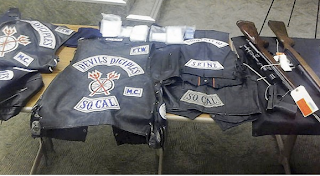Yesterday brought about a turn of events that puts Sons of Anarchy and Breaking Bad to shame. The newspapers yesterday and this morning were full of news about Cal State San Bernardino professor Stephen Kinzey, who is wanted in connection with meth drug dealing. The L.A. Times reports:
 |
| Photo courtesy Phil Willon, L.A. Times |
The San Bernardino County Sheriff’s Department on Thursday said Stephen J. Kinzey, a 43-year-old kinesiology professor, allegedly led a local chapter of the Devils Diciples Outlaw motorcycle gang and a methamphetamine drug operation that brought in tens of thousands of dollars.
Authorities arrested nine suspected mid- and street-level dealers involved in the drug ring shortly after raiding Kinzey’s home, where they allegedly found more than a pound of methamphetamine, rifles, handguns, body armor, leather biker vests and other biker paraphernalia.
Kinzey remains a fugitive and is considered armed and dangerous, officials said.
This news story elicited quite a bit of witty commentary on my Facebook page, and after the laughs subsided a bit I started thinking about why this story piqued so much interest. I think the key to this is in Kinzey’s father’s words, quoted in the LA Weekly:
“My son is a Christian. He’s a good father of a good little girl. My son doesn’t drink. My son doesn’t smoke. I don’t get it. He’s a Ph.D.“
What the Kinzey story reveals is how culturally entrenched the stereotype of a black, urban drug dealer is; when encountering a white one with advanced degrees and privilege we respond with incredulity. So, what do we rely on to reinforce our confirmation bias about the way the world works? Alternative markers of crime. The story, for example, emphasizes Kinzey’s motorcycle club activities, seizing (perfectly legal) leather vests with the meth and guns. It also hints at the fact that Kinzey’s “live-in girlfriend” (as if cohabitation were uncommon) is a Cal State San Bernardino 2005 grad, so as to imply academic improprieties as well as criminal ones (who knows what the story there is? For all we know, they could have met after she graduated, and she might not even have taken a class with him; and anyway, it’s 2011 and Robinson is 33 years old.) What these details do is provide us with some information that will trigger our culturally shared notion of the gang biker, to explain why our criminal, a university professor, doesn’t fit our default mode.
Where does the connection between motorcycling and organized crime come from? For those interested in background, this 1992 CNN story provides some information, but if you’re pressed for time you’re better off with this excellent 2005 article by William Dulaney, which provides plenty of information on the history of outlaw clubs. The “one percenters” (a term incorrectly derived from a supposed quote after a rally, implying that only “one percent” of motorcyclists were also involved in crime) have become an iconic image in American culture. Ken Kesey’s Merry Pranksters’ historical meeting with the Hells Angels (and their apprehension of the latter, documented by Tom Wolfe in his classic The Electric Kool Aid Acid Test) is best understood on a background of violent, sexist biker culture, reinforced by a genre of biker films. Now, reality is not entirely socially constructed, of course. Motorcycle clubs have been conduits for organized crime, and their members have engaged in real violence that has caused real suffering to real victims. But make no mistake; white people commit crime not only on Harleys, but also in SUVs and Honda Civics and bicycles and public transportation. And organized crime occurs not only in clubs and gangs, but in corporations as well.
This is not to say, of course, that Kinzey is being framed, or that he is not involved in meth trafficking. At this point, he is a fugitive and we have not heard his side of the story; moreover, the evidence found so far would tend to support that. I merely try to point out the ways in which a newspaper story tries to paint an etiology of criminality that might explain the discrepancy between the cultural image of the young, black, urban drug dealer, by fleshing out the image of an alternative white drug dealer using less powerful, but still effective, ways to convey nonconformism, impropriety, and propensity.

